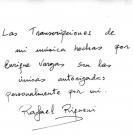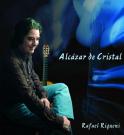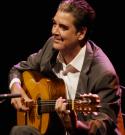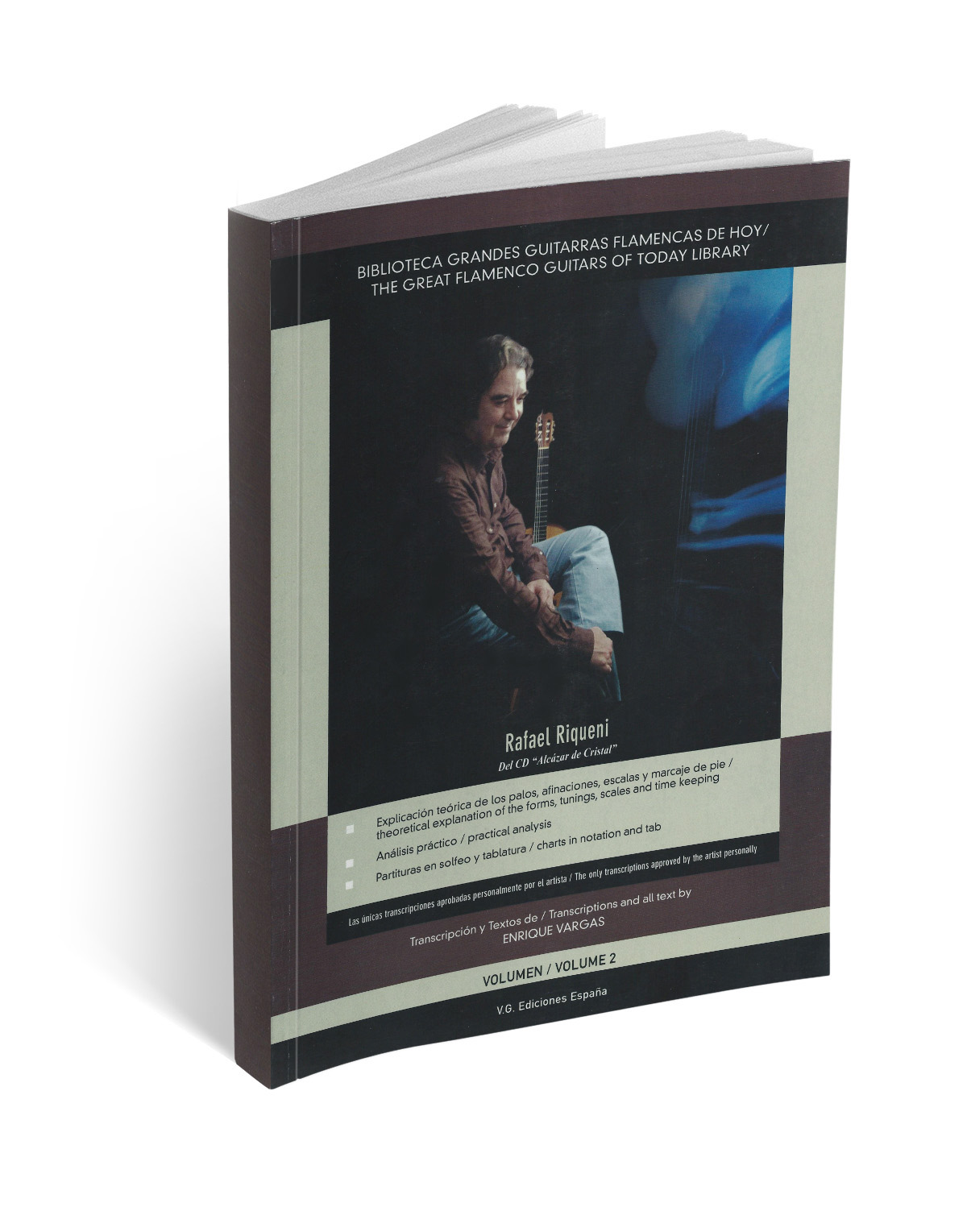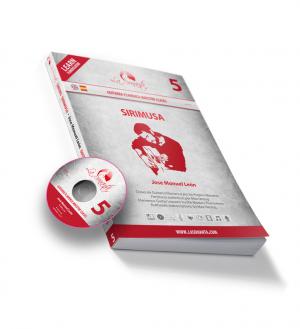169 pages sheet music and tabs with complete 2 hands fingerings from the CD "Alcázar de cristal" of 1 of the most creative and versatile innovators of the modern flamenco guitar, Rafael Riqueni. This volume 2 includes transcriptions, flamenco modes, chords, tunings, scales, tonalities, compás, palmas, foot markings, comments and analysis of the following 4 compositions "Piel de toro (rumba), Tacita de plata (Alegrias), Esta noche (Tema de amor) and Reflexion.
Bladmuziek
- Beschrijving
- Kenmerken
- Combineer met
- Video
- Levering
- Veilig betalen
- 169 Pages - ISMN M-801224-25-5
- English / Spanish
- Transcriptions by Enrique Vargas
€ 65.95
De 5e release in de flamenco master serie met de beroemde flamencogitarist en componist uit Algeciras Spanje, José Manuel León.
In deze lessen, beschikbaar in boek, DVD en online streaming, nodigt José Manuel León je uit om zijn techniek en fascinerend gitaarspel te leren. José demonstreert 6 van zijn meest opmerkelijke CD composities en herspeelt ze op een gesplitst scherm met close-ups van de linker- en rechterhand. De in detail getoonde composities omvatten de bulería 'Sirimusa', een soléa, een tango, een seguiriya en een combinatie van een fandango, Tanguillo, tiento, tango en een bulería. Het bijbehorende boek, met meer dan 170 pagina's, biedt authentieke transcripties, geschreven door Max Herzog in nauwe samenwerking met José Manuel León, in zowel standaard muzieknotatie en tabulatuur. De DVD heeft meer dan 20 minuten aan extra's om van een aantal prachtige live-optredens van José Manuel León te genieten.
Zoals bevestigd door musicologen, wordt José Manuel León beschouwd als de flamencogitarist die de revolutie van Paco de Lucía verderzet. Toeval of noet, beiden zijn van Algeciras afkomstig. Door...
Wij streven ernaar om je pakket binnen 1-2 werkdagen na bevestiging van je bestelling te versturen, uitgezonderd goederen die op bestelling zijn gemaakt of duidelijk gepersonaliseerd zijn, uitgezonderd uit voorraad zijnde producten. Tijdens de vakantieperiodes kunnen leveringen iets langer duren. De laagst mogelijke verzendkosten worden automatisch berekend bij het uitchecken. Je hoeft geen extra verzendkosten te betalen als je bestelling in meerdere pakketten of meerdere zendingen wordt geleverd.
Terugzending: Je hebt 14 dagen bedenktijd. Een retour kan je aanvragen door te klikken op 'My Account’ bovenaan links en vervolgens de rubriek ‘Retouren’ te selecteren. Als je niet tevreden bent, wordt je bestelling terugbetaald, verminderd met de verzendkosten, als we de producten in originele staat, gebaseerd op foto's genomen voorafgaand aan de zending, terug ontvangen hebben. De online tracking van de transportdienst zal het moment van ontvangst bij je thuis identificeren.
Aankopen in de winkel of verzegelde producten zoals dvd's, boeken en cd's, evenals aangekondigde uitverkoop, komen niet in aanmerking voor retourrecht. Als u het product wilt retourneren, moet u er begrip voor hebben dat u verantwoordelijk bent voor de verzending en de verzender. Omdat wij een kleine speciaalzaak zijn en het voor ons vrijwel onmogelijk is om het beste transportmiddel bij u in de buurt te bepalen, kunnen wij de retourzending niet organiseren en kunnen we de kosten van de retourzending niet terugbetalen. Wij raden u ten zeerste aan om altijd gebruik te maken van verzekerde verzending en uw retourzending optimaal te verzekeren tegen verlies of beschadiging tijdens transport voor de aankoopwaarde van het te retourneren product. Alle producten dienen in de originele, onbeschadigde doos en verpakking aan ons geretourneerd te worden. Als de producten tekenen van slijtage vertonen die resulteren in een waardevermindering, behouden wij ons het recht voor om de terugbetaling dienovereenkomstig te verminderen. Ga daarom zorgvuldig om met de producten of instrument(en) zolang u deze in uw bezit heeft en bespeel of gebruik ze niet nadat u ons heeft laten weten dat u het product wilt retourneren. De verantwoordelijkheid voor het product ligt bij u, de klant, totdat het product door ons is ontvangen. Speciaal bestelde producten, op maat gemaakte bestellingen of goederen die zijn vervaardigd of gewijzigd volgens klantspecificaties en waarvoor een niet-restitueerbare aanbetaling is gedaan, zijn uitgesloten van dit retourbeleid. Wij zullen ons uiterste best doen om een voor alle partijen aanvaardbare oplossing te vinden, maar er is geen garantie dat wij het betaalde bedrag voor het maatwerkproduct volledig kunnen terugbetalen.
Opdat je steeds op de hoogte bent van de actuele voorwaarden, wordt per individuele bestelling telkens gevraagd om voorafgaand akkoord te gaan met de voorwaarden.
Deze vraag van acceptatie van deze voorwaarden zal specifiek aan u worden gesteld vóór elke individuele bestelling die u op onze site plaatst.
Als u niet akkoord gaat met een van deze voorwaarden, raden wij u aan om uw bestelling niet te plaatsen en contact met ons op te nemen.
Je veiligheid en privacy ... onze prioriteit.
Je betalingen en privacy zijn volkomen veilig door de anti-fraude systemen van onze servers. Elke keer als je betaalt bij La Sonanta, wordt je kaartnummer en identiteit versleuteld en onzichtbaar opgeslagen door de bescherming van onze 3D Secure™ technologie. Je kredietkaartgegevens zijn bij niemand bekend. De La Sonanta gecodeerde en TLS geverifieerde technologie zorgt voor een uiterst veilige online shopping ervaring.
Naast beveiligde online betalingen met alle grote creditcards en betalingsmethoden, kan je ook kierzen om te betalen met bankoverschrijving voor al je online bestellingen.




